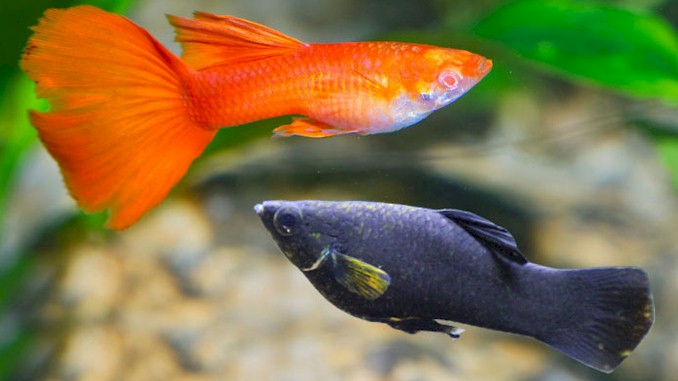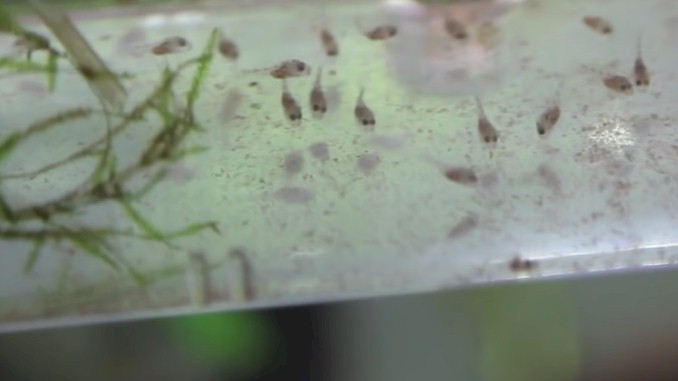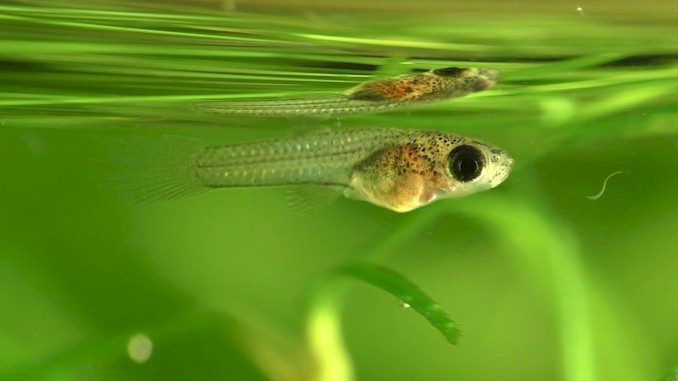How to Tell If a Guppy Fry Is Male or Female
If you are a guppy enthusiast like me, you probably want to know the gender of your fry as soon as possible. This can help you plan your breeding strategy, separate males and females if needed, and enjoy the beauty and diversity of your guppy population. But how can you tell if a guppy fry is male or female? Is there a reliable way to identify their sex before they reach maturity? In this blog post, I will share with you some tips and tricks that I have learned over the years of keeping and breeding guppies. You will learn how to use physical characteristics, behavior patterns, and genetic markers to determine the gender of your guppy fry with confidence and accuracy.
To identify male and female baby guppies is to find the gravid spot and rounded stomach in females and the gonopodium in males.
While knowing the physical characteristics is an essential first step to determine the gender of your guppy fry, there are many other factors to consider that can affect their development and behavior. In the following paragraphs, I will delve deeper into the nuances of guppy fry gender and provide valuable insights that will help you raise healthy and happy guppies. Whether you’re a beginner or an experienced guppy owner, this article will give you the tools and knowledge to properly care for and breed your guppy fry. So, let’s continue reading to learn more about the fascinating world of guppy fry gender!
Best Time to Sex Guppy Fry
When it comes to determining the best time to sex guppy fry, age is a crucial factor to consider. Fry typically start to show their sexual characteristics at around 4-6 weeks of age. At this point, the males will start to develop a gonopodium, a modified anal fin that is used for fertilization. The females, on the other hand, will start to develop a gravid spot, which is a dark spot near their anal fin that indicates that they are carrying eggs.
While age is an important factor, it is not the only one to consider. The size of the fry can also provide clues as to their gender. In general, males tend to grow at a faster rate than females, and as such, they will often be larger in size. Additionally, male guppies will have a more streamlined body shape, while females will have a rounder shape due to their carrying of eggs.
Finally, behavior can also be a useful indicator of a fry’s gender. Males are known to exhibit more active and aggressive behavior, often chasing after other fish in the tank. They may also display their gonopodium as a way of asserting their dominance. Females, on the other hand, tend to be more passive and may spend more time resting in the plants or other hiding spots in the tank.
In my experience, the best time to sex guppy fry is when they are around 6-8 weeks of age. At this point, the males will have developed their gonopodiums and will be displaying more active behavior, while the females will have developed their gravid spots and will have a rounder body shape. However, it is important to note that every fish is different, and some may develop faster or slower than others.
When it comes to actually sexing the fry, there are a few different methods that you can use. One common method is to look for the gonopodium or gravid spot, as mentioned earlier. Another method is to use a magnifying glass to look for the presence of a genital papilla, which is a small protrusion located near the anus. This method can be a bit more difficult, as the papilla can be quite small and difficult to see.
How to distinguish between male and female guppy fry using physical characteristics?
As mentioned earlier, determining the gender of guppy fry is important because it affects how you care for them. Here are some physical characteristics to look for when trying to differentiate between male and female guppy fry.
- Gravid spot and rounded stomach in females: Female guppies have a round, swollen belly because they carry and give birth to live young. You can easily spot a gravid spot, which is a dark triangle-shaped mark on the lower abdomen of female guppy fry. This gravid spot becomes more visible as the fry mature.
- Gonopodium in males: Males have a modified anal fin called a gonopodium, which is used to transfer sperm to the female during mating. It is longer and thicker than the female’s anal fin, and it also has a pointed end. This feature can be observed as early as 2-3 weeks old.
- Size and coloration differences: Male guppy fry tend to be smaller than females and have brighter colors. However, this is not always a reliable way to determine gender, especially in young fry. As they mature, males will develop a more colorful and intricate pattern, while females will have a more subdued coloration.
- Behavioral differences: In addition to physical characteristics, there are also behavioral differences between male and female guppy fry. Males are generally more active and aggressive, while females are more passive and tend to hide in vegetation. Males will also chase and court females when they are ready to mate.
By observing these physical characteristics and behaviors, you can accurately determine the gender of guppy fry. However, it is important to note that sexing fry can be challenging, especially for beginners, and mistakes can be made.
Other factors to consider when determining the gender of guppy fry
Apart from physical characteristics, there are other factors that can help you determine the gender of guppy fry. One such factor is the behavior of the fry. Male guppies tend to be more active and aggressive than females, often chasing and nipping at other fish in the tank. Female guppies, on the other hand, tend to be more docile and peaceful.
Another factor to consider is the age of the fry. It can be challenging to determine the gender of guppy fry when they are very young. However, as they grow and develop, the physical differences between males and females become more apparent. It is essential to monitor your fry’s development closely to ensure that you can accurately determine their gender.
The color of the fry can also be a useful indicator of their gender. Male guppies are typically more colorful and vibrant than females, with brighter hues and more pronounced patterns. In contrast, female guppies tend to be duller and less colorful, with more subdued markings.
Finally, genetics can also play a role in determining the gender of guppy fry. Some strains of guppies have a higher percentage of males or females, making it easier to determine the gender of the fry based on their lineage.
By considering these additional factors along with physical characteristics, you can become more confident in determining the gender of your guppy fry. It is essential to take a holistic approach and gather as much information as possible to ensure that you can accurately identify the gender of your fish.
Why is it important to determine the gender of guppy fry?
Determining the gender of guppy fry is an essential part of guppy fishkeeping, and it’s crucial to know the gender of your fry to properly care for and breed them. Guppies are one of the most popular aquarium fish species, and they’re widely known for their vibrant colors, active personalities, and ease of care. However, if you’re interested in breeding guppies or want to maintain a healthy guppy population, it’s crucial to be able to determine the gender of your guppy fry accurately.
One reason why it’s important to determine the gender of guppy fry is to prevent overcrowding in your aquarium. If you have too many male guppies in your tank, they may become aggressive and territorial, leading to fighting and stress among your fish. On the other hand, having too many females can lead to excessive breeding and overpopulation, which can also cause stress and health problems for your fish.
Another reason why it’s important to know the gender of your guppy fry is to facilitate successful breeding. Breeding guppies can be a rewarding experience for fishkeepers, but it requires a good understanding of guppy reproduction and behavior. Male and female guppies have different mating behaviors, and knowing the gender of your fry can help you set up your breeding tank properly and increase your chances of success.
Furthermore, knowing the gender of your guppy fry can also help you identify potential health problems or abnormalities in your fish. For example, if you notice that all of your guppy fry are male, it could be a sign of inbreeding or genetic issues. Similarly, if your female guppy fry are not developing a gravid spot or appear to be unhealthy, it could be a sign of disease or poor water quality.
Overall, determining the gender of guppy fry is an important part of guppy fishkeeping that can help you maintain a healthy and happy fish population. Whether you’re a beginner or an experienced guppy owner, understanding the nuances of guppy fry gender can help you provide the best care for your fish and increase your chances of successful breeding.
The role of gender in guppy fry breeding
The gender of guppy fry is a critical factor in breeding them successfully. Breeding involves pairing up male and female guppies to produce offspring, and it’s essential to identify the gender of your fry before breeding them. Breeding guppies can be a rewarding experience, but it’s essential to understand how the gender of your fry affects the breeding process.
Male guppies have a modified anal fin called a gonopodium, which they use to fertilize female guppies. Female guppies, on the other hand, have a gravid spot, a dark spot on their abdomen where they carry developing eggs. By identifying the gender of your fry, you can ensure that you have the right mix of males and females for breeding.
Breeding guppies can be an involved process, but it can also be a lot of fun. To breed guppies successfully, you’ll need to create the right environment for them to mate and raise their fry. It’s also essential to pay close attention to the health and well-being of your guppies to ensure that they are in the best possible condition for breeding. With careful attention and proper care, you can successfully breed guppies and enjoy watching their offspring grow and thrive.
Tips for raising healthy and happy male and female guppy fry
Once you have determined the gender of your guppy fry, it is important to take proper care of them to ensure their health and happiness. Here are some tips to help you raise healthy and happy male and female guppy fry:
- Provide a suitable habitat: Guppy fry require a clean and spacious aquarium to thrive. A tank size of at least 10 gallons is recommended for a small group of guppy fry. A sponge filter can be used to provide gentle filtration without harming the fry.
- Feed them nutritious food: Guppy fry have small mouths and require a special diet. Commercial fry food or crushed flakes can be fed several times a day in small amounts. Live or frozen food such as baby brine shrimp, micro worms, or daphnia can also be given to provide additional nutrition.
- Maintain water quality: Frequent water changes are essential to keep the aquarium water clean and healthy. A 25% water change every week is recommended for guppy fry. Make sure the new water is dechlorinated and at a similar temperature to the existing water.
- Monitor their growth: Male and female guppy fry grow at different rates, so it is important to monitor their growth to ensure they are developing properly. Females will usually grow larger and rounder, while males will develop a gonopodium and display more vivid colors.
- Keep the tank peaceful: Guppy fry are peaceful and do well in a community aquarium with other peaceful fish. Avoid keeping them with aggressive or territorial fish that may harm them.
Do Female Guppy Fry Grow Faster Than Males?
When it comes to guppy fry growth, there are many factors to consider, such as temperature, diet, and water quality. However, one commonly held belief is that female guppy fry tend to grow faster than males. Is there any truth to this claim?
According to a study published in the Journal of Aquatic Biology and Fisheries, there is some evidence to suggest that female guppy fry do, in fact, grow faster than males. The study found that in a controlled environment with optimal conditions, female guppy fry grew faster than males, and by the end of the experiment, they were significantly larger in size.
One reason for this difference in growth rate could be due to the fact that female guppy fry tend to be more active and have a higher metabolic rate than males. Additionally, females may invest more energy into growth than males, as they need to develop the resources necessary for reproduction.
However, it’s important to note that this study was conducted in a controlled environment and may not reflect real-world conditions. Other factors, such as genetics and social hierarchy, may also play a role in guppy fry growth.
In any case, whether or not female guppy fry grow faster than males, it’s essential to provide a healthy and balanced diet, clean water, and a suitable temperature for optimal growth. By doing so, you can ensure that your guppy fry, regardless of their gender, will thrive and reach their full potential.
Conclusion
If you’re struggling to determine the gender of guppy babies at first, don’t worry – it takes some practice to get it right. With time and experience, you’ll become more proficient at identifying the subtle differences that distinguish male and female guppies.
While some fish species do not exhibit sexual dimorphism and can’t be identified by physical characteristics alone, guppy fry are relatively easy to distinguish. However, it may take some time before the gender of guppy fry can be reliably determined, as it is more apparent as they mature.
Whether you’re raising guppy fry as a hobby or for commercial purposes, it’s essential to know how to differentiate male and female fry so that you can separate them. This separation can help control their population, promote healthy growth and development, and prevent interbreeding, which can lead to genetic problems.







